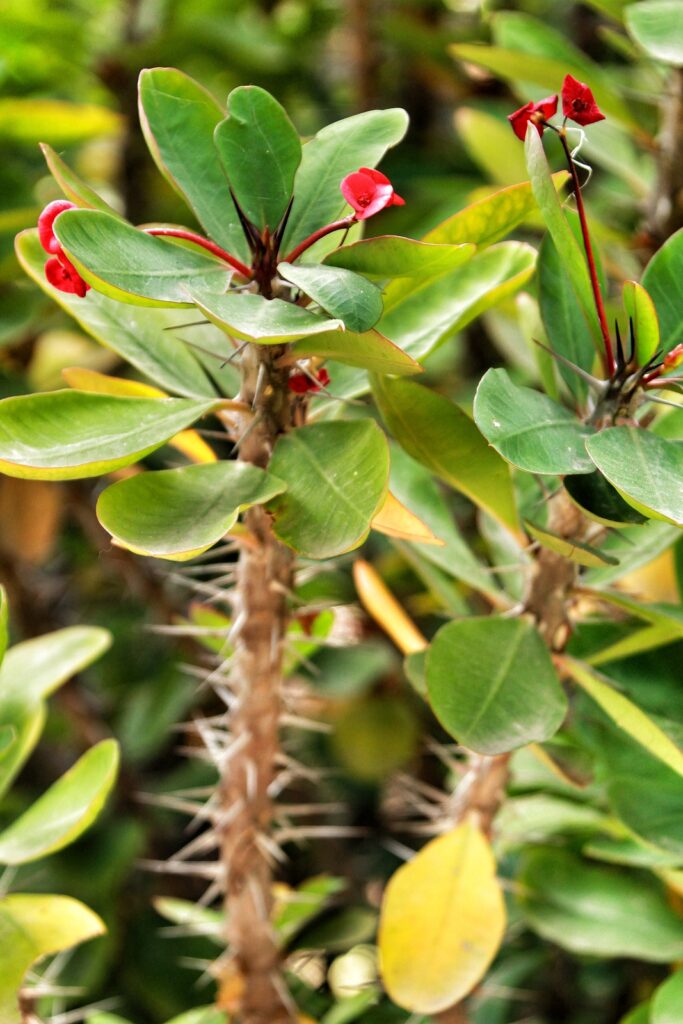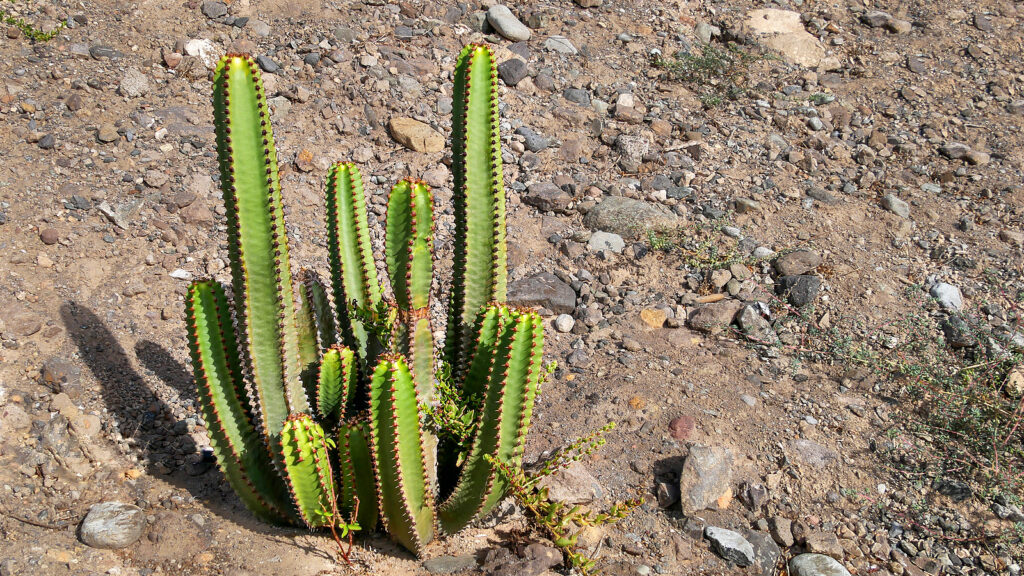Euphorbia is a genus of more than 2,000 species; about 200 are succulents. Euphorbia succulents have green bodies, and some have spines. But Euphorbias, even with spines, are not cacti; Euphorbias do not have areoles. (Cacti have areoles; aereoles are modified branches from which spines grow.)
Euphorias succulents are generally distinguished by their strong, sculptural shapes and those shapes vary. Some are squat and cushion-like, some are columnar, some are tree-shaped, and some are pineapple-shaped. All have one defense mechanism in common; when disturbed they release a glue-like liquid; this is a defense against insects and animals.
Euphorbia succulents make excellent house plants. They are slow-growing and reasonably tolerant of dry indoor air. They are best placed in a well-ventilated spot.
Euphorbia succulents need regular watering. If watering stops, Euphorbias stop growing. Even when water is resumed, Euphorbias will take time to start growing again.
Good Products for Seed Starting Success at Amazon:
- Jump Start Germination Station w/Heat Mat Tray, 72-Cell Pack, Dome
- Espoma Seed Starting Mix
- 200 Count- Jiffy 7 Peat Soil Seed Starting Plugs
- Seed Starter Kit with Humidity Dome (120 Cells Total Tray)
- AgrobriteT5 Fluorescent, 2-Foot, Grow Light System
Get to know Euphorbia
- Plant type: Succulent, member of the Euphorbia family
- Hardiness temperature: Hardy to 55℉ (13℃)
- Optimal growing temperature: day, 65° to 70°F (18° to 21°C); night, 50° to 60°F (10° to 16°C
- Shape and size: Varies depending on the species from a few inches tall to more than 30 feet tall.
- Flowers: Cup-shaped flower, called a cyathium
- Bloom time: Summer
- Uses: Cactus and succulent garden, rock garden, houseplant
- Common name: Euphorbia
- Genus name: Euphorbia
- Family name: Euphobiaceae
- Origin: Africa, Madagascar

Planting Euphorbia
- Grow Euphorbia in porous, well-drained soil rich in loam and sand; use a cactus mix.
- Potting mix: Mix 2 parts potting soil, 1 part vermiculite, and 1 part sphagnum moss.
- Euphorbias vary in their tolerance to direct sunlight; bright light, but not direct sunlight, is optimal.
- Indoors give Euphorbia bright, filtered light from southern exposure.
How to water and feed Euphorbia
- Euphorbias need regular water; the soil should be just moist, not wet. It is better to water too little than too much.
- Keep soil evenly moist, not soggy. Avoid overwatering. Humidity is best at 40% to 50%.
- Fertilizer Euphoria with a mild liquid cactus-succulent fertilizer.
- Feed Euphorbia weekly, summer through fall, not in winter.
Euphorbia care
- Trim Euphorbia stalks back and repot in spring.
- Euphorbia becomes dormant after blooming. Set Euphorbia in a cool place with filtered light. Water just enough to keep the soil from completely drying out; withhold fertilizer. Resume watering and repot in early spring, when new growth appears. To induce blooming, alternate 14 hours of darkness with 10 hours of light for 8 weeks.

Growing Euphorbia as a houseplant
- Euphorbia fulgens, scarlet plume, and E. milii, crown of thorns, are commonly grown as houseplants.
- Euphorbia needs direct light, average room temperature, and low humidity.
- Keep the soil fairly dry between waterings.
- Fertilizer Euphorbia in spring and summer.
- Repot Euphorbia only when the plant outgrows its pot; repot with a cactus mix.
Euphorbia pests and diseases
- Check for aphids, mealybugs, spider mites, and scale. Keep out of drafts.
Euphorbia propagation
- Euphorbia is propagated from seed, cuttings, rhizomes, offsets, and occasionally from leaves.
Euphorbia species to grow
- Euphorbia aggregate. Cactus-shaped succulent with colorful red spines.
- E. bepleurifolia (pinneapple euphorbia). Thick stems which brown scale-like tubercles; resemble a pineapple or pine cone; light green leaves appear in spring and remain until winter.
- E. canariensis. Candelabra shape that can grow to treelike stature.
- E. caput-medusae (Medusa’s head). Globose crown with serpentine-like branches, about 2 feet long; some branches are often buried; not symmetrical; a dwarf spineless species, grows to 12 inches (30 cm) tall with green, ribbed branches snaking out from a sturdy stem; branch ends are tufted with small leaves and turn upwards.
- E. cereiformis (milk barrel). Spiny, succulent shrubs grow to 3 feet tall; thick, dark green ribs have a spiral or twisted appearance; solitary, reddish-brown spines turn gray with age.
- E. fulgens, scarlet plume. Slender arching or drooping branches that grow to 2 feet long; leaves are narrow, lance-shaped to 4 inches long; flowers are surrounded by orange-red, rounded bracts and bloom in winter.
- E. grandicornis (cow’s horns) Plant with whorling branching, growing in tiers; stems are ribbed, divided into segments; individual ribs have wavelike spination.
- E. grandidens (big tooth euphorbia). Whorled branches arise from the main stem; mature plants can grow to 30 feet in native habitats, potted subjects remain small for years.
- E. horrida (African milk barrel). Barrel cactus-like shape; ribbed with toothed crest and thorns.
- E. ingens. Candelabra-type growth; stems have dark green wavy ribs.
- E. lacteal (mottled spurge, dragon bones). Spiny shrub with candelabra-shaped growth; dark green stems are edged in white; pairs of dark brown spines appear on the ridges. E. i. ‘cristata (elk’s horn) has crested distorted branches.
- E. mammillarias (corkscrew). Low-growing with cylindrical, ribbed stems; looks like a cactus.
- E. milii (crown of thorns, Christ plant). Woody stem; bright green leaves;
- E. milii var. splendens, crown of thorns. Shrub growing to 36 inches (91 cm) tall, with spiny stem and branches; leaves appear near branch tip, and fall off as plant matures; vibrant scarlet flowers (yellow to cream on hybrids) are borne at the tip, appearing spring through summer in shades of red, pink, or yellow. Excellent conditions may result in flowering throughout the year.
- E. obesa (baseball plant). Ball-shaped; dwarf spineless species, is a grayish green globe with horizontal bands of purple, measuring up to 8 inches (20 cm); spineless, tiny tubercles.
- E. pulcherrima (poinsettia). Christmas plant whose flowers (actually leaf bracts) are red, pink, or white.
- E. tirucalli, pencil tree. Grows to 5 feet tall and has a single green stem that branches into smooth, pencil-thick green tips.
- E. trigona (African milk tree, Abyssinian euphorbia). Fast-growing with dark green stems and contrasting, wavy white bands down the sides.



